#human development
Text
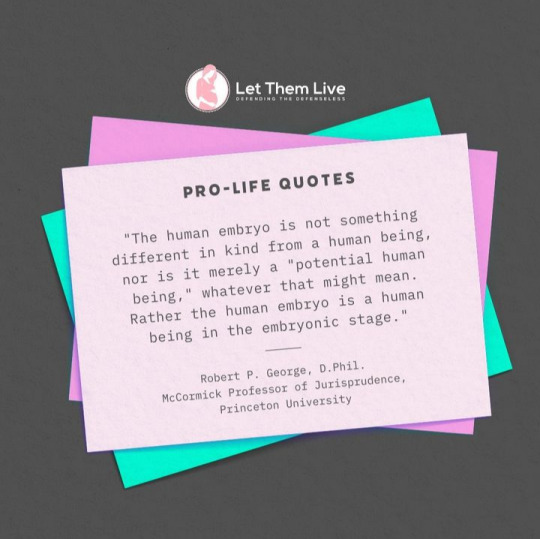
#let them live#abortion#anti abortion#pro life#pro life quote#quote#embryology#science#human development
85 notes
·
View notes
Text
There Is No Maternal Instinct In Humans
By definition, an instinct is a behavior that does not have to be learned, shows almost no variation between members of its species, and manifests in a rigid sequence of behaviors performed in response to stimulus. It's also called a fixed action pattern, or FAP. In bears and pigeons, hibernation and homing are instincts. In some species, caring for newborns is instinctive.
[...]
A rat has a maternal instinct. So, too, does the grayback goose, who immediately pushes any round object near her nest inside to incubate it, no matter if it is a billiard ball placed there by an impish ethologist or an actual egg. Round object (stimulus) produces rolling behavior (response). The less intelligent an animal, the more its survival depends on instinct.
In contrast, almost every aspect of primate behavior is mediated by a larger and more developed brain. Evolution has equipped us with a neocortex that requires us to learn in order to survive. With a neocortex, biology remains relevant but is no longer determinant. Natural selection ultimately favored flexibility. Animals that can rapidly adapt to shifting conditions have an advantage over those that can survive only a narrow range of circumstances.
[...]
The neocortex allows flexibility, but the loss of instinct also comes at a cost. Charles Snowdon, a professor emeritus at the University of Wisconsin, has spent his career studying marmosets and tamarins, cooperatively breeding New World monkeys. In most groups of tamarins, the young help to take care of babies, while in a minority of groups, they do not have this opportunity. In a field study of tamarins without prior infant-care experience, Snowdon and his team discovered that babies born to first-time parents never survived. They guessed that naive mothers and fathers didn't know enough either to parent on their own or to accept help from more experienced kin.
Later, from comparative data, his team discovered that the survival rate was much better in groups where young siblings helped out with babies. Across primates, infants born to inexperienced parents have higher risk of death. Snowdon explains, "When they don't have experience with infant-care skills, there's a very low breeding success rate. Parenting skills are learned. They're not innate, for males and females equally. Both are clumsy parents. [...] You have to learn to share care of your baby[...]"
- Darcy Lockman (All the Rage: Mothers, Fathers, and the Myth of Equal Partnership, pages 71, 71-72, 73-74). Slightly reformatted to avoid wall of text, bolded emphases added.
70 notes
·
View notes
Text
The infant, being unable to conceal well, suppresses feeling internally in order to minimize them externally. He becomes disconnected from his feelings and comes to believe that his needs are minimal. The adult counterpart of this strategy is found in the dismissing speaker ... feelings of need and hurt are minimized, memory for childhood is scant, and the importance of attachments is questioned. An important part of controlling the expression of need is to keep it from consciousness. If it is not known consciously, it does not exist. To the extent it is known, it is devalued.
Alan Sroufe, Attachment and Human Development
86 notes
·
View notes
Text

"When kids look up to great scientists the way they do to great musicians and actors, civilization will jump to the next level."
-- Brian Greene
39 notes
·
View notes
Text

my cheatsheet for my human development final!
38 notes
·
View notes
Text
"Five great enemies of peace inhabit with us - avarice, ambition, envy, anger, and pride;
if these were to be banished,
we should infallibly enjoy perpetual peace."
Francesco Petrarca.
#thought of the day#thought of today#francesco petrarca#enemies of peace#peace#avarice#ambition#envy#anger#pride#the human condition#humanity#inhumanity#human development#human life#aspiration#emotion#conflict#learning#morality#our heritage#our future#culture
57 notes
·
View notes
Text
The Environment's Role in Spiritual Growth
Spiritual growth is an inward journey that involves deepening self-awareness, a connection to a higher purpose, and a pursuit of inner peace and enlightenment. Though one might perceive spiritual growth as purely internal, the environment plays an instrumental role in shaping this voyage.**The Outer Reflects the Inner**: Spirituality isn’t limited to the realm of meditation, prayers, or religious…

View On WordPress
#Agency#Cultural Norms#Emotional Climate#Enlightenment#Environment#Environmental Genetics#genetic predisposition#Human Development#Inner Peace#Introspection#Life Trajectory#Nature#Peer Influence#Personal Sanctuary#Self-Awareness#Socialization#Spiritual Community#Spiritual Growth#Spiritual Journey#Transformation
11 notes
·
View notes
Text
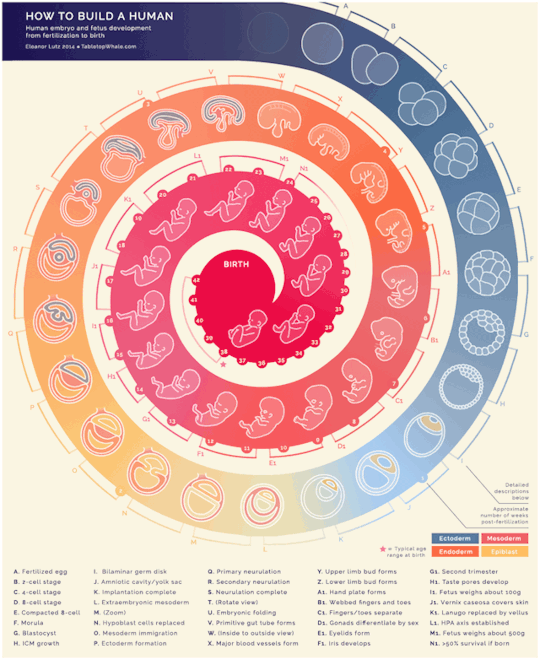
The development of a fetus, from zygote to birth, designed by Eleanor Lutz.
Guys this is FASCINATING!!! Try picking one at the beginning and following it all the way around!
I don’t understand all the terms but I did find it really interesting how things are broken up by weeks:
Week 1: A, B, C, D, E, F, G, H, I, J
Week 2: K, L, M, N
Week 3: O, P, Q, R, S, T, U
Week 4: V, W, X, Y
Like that’s MOST of the stuff happening in FOUR WEEKS! Quote from the Vox article:
“Perhaps the most interesting thing here is that all of this happens within four weeks or so of fertilization. At that point, the fetus is still tiny—just a millimeter or two long, and less than a thousandth of its weight at birth—but all the basic differentiation that will lead to various organs and structures within the infant has already occurred.” (Emphasis added)
#fertilization#birth#human development#babies#fetus#pro-life#pro-choice#just want people to see it#it's so cool
51 notes
·
View notes
Text
Like did you know, a fetus begins development as a female (hence why males have nipples but don’t lactate usually) because the X chromosome is sensed first. Only after a period of time is the Y chromosome activated, causing the rest of the development to be under the influence of testosterone. That’s why guys have the line down their genitals: it’s where their female reproductive organs began to form but then sealed up in utero to allow for the formation of male reproductive organs :)
#biology#bio#ap bio#biology be like#anatomy#human anatomy#human biology#human development#human reproduction#science#biological sciences#bio facts#anatomy facts#reproduction
12 notes
·
View notes
Quote
The archbattle in the universe is always: evolution verses egocentrism. The evolutionary drive to produce greater depth is synonymous with the drive to overcome egocentrism, to find wider and deeper wholes, to unfold greater and greater unions. A molecule overcomes the egocentrism of an atom. A cell overcomes the egocentrism of a molecule. And nowhere is this trend more obvious than in human development itself.
Ken Wilber, A Brief History of Everything
#quote#Ken Wilber#Wilber#A Brief History of Everything#integral#ego#egocentrism#evolution#evolutionary#human being#human development#development#Integral Theory#biology#psychology#universe
64 notes
·
View notes
Text
saw this meme today

and i was all instinctively ready to scoff like "how silly, that's not *really* how it works"
but then
i thought back to when *i* was 5—aka, most of my earliest memories (i don't remember being 4 so well lol i was still vibing)—and some of those memories are:
just thinking about life and realized i was gnc/nonbinary (didn't have the terminology obviously, so i basically had to make up my own Baby's First Gender Theory based on observation)
just thinking about life and realized i could imagine literally anything and started making up a utopian sci-fi/fantasy world that i continued playing pretend and worldbuilding in for the entire next decade
just thinking about life and got into a spiral over how i couldn't read yet even though i had almost reached the very wizened age of six, envisioning the entire rest of my life (aka... being a Big Kid and then Old) stretching out before me where i *never* learned how to read, a dreadful vision, and going to my mom in tears with the exact same kind of overthinking-themed anxiety breakdown i have battled repeatedly as an adult
... in conclusion, the framework of the future adult already exists in the toddler, and the personality of the toddler is observable in the adult, and kids just have these enormous, profound inner lives in those tiny little heads, dude, and the meme is right... 4-year-olds are HELLA existential. it's kinda mind-blowing. you should definitely ask a 4-year-old some deep questions about the meaning of life.
(also, as someone who has spent a bunch of time with small children... the Thinking begins way, wayyy earlier than 4. you can see them working up to it as soon as there's long enough breaks between crying as a newborn. that's the magic of it all)
#children#human development#i should study this stuff more formally it makes me such a joyous nerd#'what would you tell your child self?'#'... don't worry bro you definitely learn how to read. in fact you're going to have outstanding reading comprehension'#hilarious in hindsight
2 notes
·
View notes
Photo

A book that’s at once both exciting because of the brilliance of its synthesis and vision, but also depressing because of how it clarifies the mental poverty of so much of current existence.
I’ve dropped almost everything else I’m reading in order to get through this before the 3 week return deadline.
The contrast between the educational philosophy of this book versus what conservative legislators (especially) are doing with education in the US is vast. (You could say this about any number of books or ideas, of course.)
It’s easy as pie to get large inarticulate numbers worked up about fantasy problems like woke and critical race theory and LGBT-themed library books, but it’s impossible to find an equivalent number with the power to push these postformal education ideas ahead.
Conventional, reactionary, conservative and authoritarian educational practices easily reproduce themselves since they’re mostly operating on low-effort duplication of current practice. Rote memorization, acquisition of sterile facts, suppression of dissent, etc., are hallmarks of this educational approach - static social reproduction.
Adopting postformal pedagogies on the other hand is in a paradoxical situation. It would seem to require significant numbers with postformal (or, using an equivalent term, postconventional) psychological and cognitive development to get it going on a mass scale, but this is hugely complicated by the fact that people functioning at postformal levels are generally lacking and might only come into existence if there were significant numbers of them to begin with in teaching positions, but if this were the case then the problem would probably be in some degree of resolution.
Examples of this paradox or dilemma are commonplace in other areas. For example, if you’re at a low or mid level in terms of your critical thinking ability, you will not be able to imagine what it’s like to have a high level ability. Thus, you don’t see your current function as necessarily problematic. Or, if you don’t understand statistics, you won’t grasp whether a given public poll is valid, relevant, significant, or otherwise.
#jennifer gidley#futures studies#postformal#postconventional#education#philosophy of education#human development#stage theories of human development#teaching
7 notes
·
View notes
Text
"A Suffocating Masculinity"
{W}e are saddled with with deeply ingrained cultural notions about what men and women are best at and how they should conduct themselves.
Men should do and think for themselves (behaving "agentically"), while women should do for and think of others (behaving "communally"). While this has harmed men in meaningful ways —what has been called the loneliness epidemic impacts them disproportionately— it remains the precursor to status and success.
{...}
{A} boy's development involves the repression of the need for relationships and sense of connection and then also, eventually, "the reproduction of male dominance." Or, as the actor and author Michael Ian Black described it in a 2018 New York Times op-ed about young men and violence: "Too many boys are trapped in the same suffocating, outdated model of masculinity, where manhood is measured in strength, where there is no way to be vulnerable without being emasculated, where manliness is about having power over others."
The emphasis on masculine power among boys start young. By nineteen months old, boys respond positively to other boys only when they're engaged in masculine-type activity. In contrast, girls react positively to other girls no matter their style of play. In Why So Slow?, Valian describes play studies of young children: "Masculine activities gradually acquire a superior status, initially through fathers' reactions to boys' choices of feminine activities and later through the disapproval of male peers. . . . [B]oys were especially likely to punish their male peers for feminine choices by ridiculing them or interfering with their play physically or verbally. Boys thus learn to devalue feminine activities and to shun them in order to avoid compromising their status. Boys cannot risk the stigma of being girl-like.
{...}
Men are {...} not women, and are not expected to take note of other people in the same way, denying themselves, as Zimbabwean gender equality activist Jonah Gokova has said, "the experience of being fully human."
- Darcy Lockman (All the Rage: Mothers, Fathers, and the Myth of Equal Partnership, pages 102, 104, 110). Bolded emphases added; square brackets original, curly brackets designate editorial changes.
#feminism#masculinity#fatherhood#relationships#peer pressure#human development#childhood#dehumanization#All the Rage
12 notes
·
View notes
Text

Seeing double
#seeing double#rainbow#alt aesthetic#gothique#human development#glasses#ginger#cool look#cokegirls#peircingsandtattoos
8 notes
·
View notes
Text
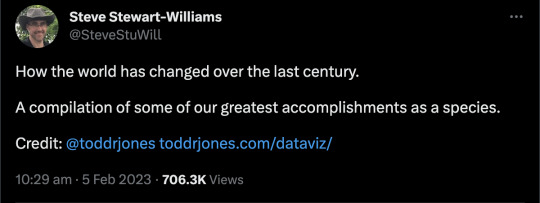
#human progress#human development#life expectancy#GDP#gross domestic product#education#water#sanitation#child mortality#child death#religion is a mental illness
88 notes
·
View notes
Text

Blue agave grows in a field in the state of Jalisco, Mexico. Photo by Matt Mawson/Getty Images
Jonathan Drori’s interest in plants stems back to his childhood growing up in southwest London. His family lived within walking distance of the Royal Botanic Gardens, Kew, home to one of the most prestigious and diverse collections of botanicals in the world. His parents would take him and his brother on frequent trips to the gardens, exploring the grounds and discovering new plant species from around the world.
“My father was trained in botany but spent his career as an engineer, while my mother was interested in the aesthetics of plants,” he says. “She would carry a magnifying glass in her purse, and we’d go to Kew every week to look at the individual plants.”
Fast forward several decades and now Drori is a botany expert in his own right, even serving as a trustee at Kew for a stint. He’s built a career as an educator, focusing on conservation, the environment and technology, and is also a prolific author. His 2021 book, Around the World in 80 Plants, follows on the heels of his bestseller, Around the World in 80 Trees, and serves as an illustrative compendium that explains the historical and cultural significance of different plant species, from amaranth to wormwood. Using a map as his guide, he selected a range of plants from around the world, each with an interesting backstory that focuses on the cultural significance and botanical structure of each species.
While Drori's latest book takes a more leisurely pace, for our purposes, here is a quick spin around the globe, through eight standout plants—some of which might be growing in your own backyard.
Kelp (Scotland and the United States)

Sunlight streams through a forest of giant kelp. Douglas Klug via Getty Images
With its long tangles of sinuous leaves that bend and sway with the ocean waves, kelp (genus Laminaria) is a common sight along the Atlantic and Pacific oceans and is especially prolific in the cold waters lapping up against the Scottish and American coastlines. Kelp forests not only provide ample habitat and nutrition for invertebrates and fish, such as rockfish, crabs and jellyfish, but they also offer a number of important ingredients for us land dwellers, too. Beginning in the 18th century, kelp ash, a residue that’s the result of drying and burning kelp leaves, was used by glassmakers as soda, an ingredient that forces sand to melt at a lower temperature. “Kelp was also a prized source during World War I, and the acetone extracted from it was used to make explosives,” Drori says. Nowadays, kelp is harvested for a much sweeter reason: its alginates (part of the cell walls of brown algae) are one of the key components used to make ice cream.
Wormwood (France)

Wormwood. Nahhan via Getty Images
Wormwood (genus Artemisia), an aromatic herb with silvery leaves and bright yellow buds, is native to Europe and can be found growing in fields throughout the continent, but particularly in France, where it’s used as one of the main ingredients in making absinthe. Although there are different thoughts on who actually invented absinthe, according to one story it's believed that the first person to use wormwood to make absinthe was a woman in Switzerland by the name of Madame Henriod. Called the “green fairy,” absinthe is a liquor that’s been immortalized in pop culture for its supposed psychedelic properties, which have led imbibers to “go mad," Drori says. (Case in point: Artist Vincent Van Gogh lopped off his ear after allegedly partaking in a few too many rounds of the potent tipple.)
Papyrus (Egypt)

Papyrus. Ryan Faas via Getty Images
During antiquity, wild papyrus (Cyperus papyrus) grew prolifically throughout Egypt, sprouting up along the Nile River and other large bodies of water, reaching heights of 16 feet. The Egyptians were so drawn to the towering plant, with its splayed-out tufts of leaves, that they began harvesting it to eat. “Papyrus swamps were the larder of the day, they were teaming with life,” Drori says. “They didn’t have refrigeration back then, so it was a fantastic source of fresh food.” The Egyptians soon discovered that by drying the soft white pith running through the plant’s thick reeds and weaving them together, they could make paper. Word of this new commodity spread to Europe, and the rest is, well, history.
Vanilla (Madagascar)

Green vanilla pods. miniloc via Getty Images
Native to Mexico, but now grown predominately in Madagascar, vanilla (Vanilla planifolia) is one of the most expensive spices in the world, fetching $50 or more per pound. And yet there’s good reason behind the hefty markup: Vanilla is also one of the most difficult plants to cultivate. Since it doesn’t self-pollinate, vanilla’s flowering blooms must be pollinated by hand in order for them to produce pods. What’s more, the horn-shaped flowers only bloom for one day, forcing vanilla growers to search plants regularly for new flowers. Once a bloom is found, growers use a pollination technique that’s 200 years old, which involves piercing the hermaphroditic plant’s membrane separating the male and female parts of the flower and squeezing them together to transfer the pollen in what’s called “consummating the marriage.” The steep price tag for the beans has resulted in a black market. However, growers have found a way to thwart thieves. “To prevent people from stealing their beans, farmers will incise a code that identifies themselves and their farm on each pod, similar to ranchers branding their cattle,” Drori says.
Lotus (India)

Purple lotuses. Sven Scholz / 500px/Getty Images
Designated as the national flower of India, the lotus (Nelumbo nucifera) has been a sacred symbol of the country for thousands of years. These aquatic plants, whose magnificent blooms come in shades of pink, yellow and white, are often seen floating languidly on the surface of ponds, marshes and other slow-moving bodies of water. The lotus is a commonly depicted motif in art as well, in particular amongst Hindus who believe that Brahma, the creator of the universe, emerged from the navel of Lord Vishnu while seated on top of a lotus flower. Not only is the stunning plant cherished for its beauty, but the lotus root is recognized as an important food staple across Indian, Japanese and Chinese cuisines, calling to mind the mild vegetal flavor of artichokes, but with a much more satisfying crunch.
Chrysanthemum (Japan)
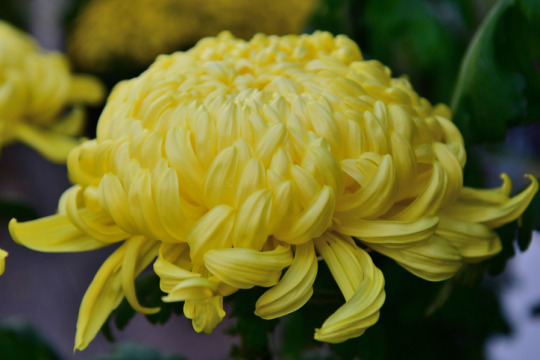
Chrysanthemum. magicflute002/Getty Images
Similar in appearance to a cheerleader’s pom poms, chrysanthemums (Chrysanthemums spp.) are some of the showiest plants found in nature. The blooms come in a variety of colors and forms, with some cultivars displaying single or double layers, while others burst with spherical petals. In the United States, chrysanthemums (or simply mums) are most commonly seen during the cooler, autumn months, decorating porches alongside pumpkins and stalks of corn; however, in the Far East, where they originated, they’re a common emblem and can be seen blooming in gardens in the autumnas well as in traditional paintings. These perennials are particularly revered in Japanese culture. “The chrysanthemum is associated with perfection and nobility,” he says. “The Imperial Seal of Japan is a chrysanthemum. It’s also regarded as one of the four ‘noble species’ alongside plum, orchid and bamboo.”
Amaranth (Peru)
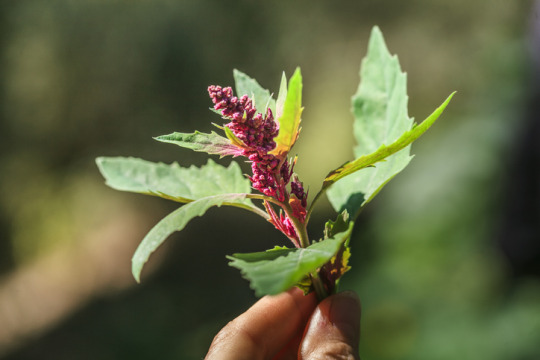
Amaranth. Photo by Enrique Díaz / 7cero/Getty Images
Amaranth falls into the category of forgotten grains, since it’s often overshadowed by more readily available whole grains like oats and rye. However, it has gained popularity in recent years thanks to being highly nutritious and a good source of amino acids. In fact, prior to the Spanish Conquest in 1519, amaranth was a staple foodstuff of the Inca and Aztec empires. The Aztecs used the seeds of the scruffy garnet plant for ceremonial purposes, mixing amaranth flour with agave syrup and molding the mixture into figures representing important deities within their culture, such as Tlaloc, the god of rain. Upon seeing this, Spanish conquistadors banned the crop, believing “the practice to be the work of the devil,” Drori says. In modern-day Peru, a popular street snack called turrones is made by popping the seeds—similar to popcorn—and mixing it with agave syrup or molasses in a nod to the Aztecs.
Blue Agave (Mexico)

Blue agave. Photo by Matt Mawson/Getty Images
Blue agave (Agave tequilana) can be found in parts of the southern United States and Central America, but it’s most frequently grown in a sunny swath of rolling hills in Jalisco, a state in the western portion of Mexico. It’s there, in a town called Tequila, where the world’s top distillers make tequila using the piñas (hearts) found at the center of the spiky blue succulents. While the leaves of the blue agave are covered in barbs and inedible, the flowers of the plant are the source of agave syrup, a clear, sticky liquid similar to honey often used to sweeten up margaritas and other drinks. Once fermented, it turns into pulque, a milky alcoholic drink similar to low-octane beer that was originally used by the Aztecs during religious ceremonies. “Drawings of the goddess of fertility, Mayahuel, can be seen in the Aztec culture depicting the deity as a being with 400 breasts dripping with pulque,” Drori says. Today pulquerias serving the drink can be found in cities across Mexico.
#Around the World in Eight Plants#food#plants#human development#diet#nutrition#human existence#flowers#food and humans
3 notes
·
View notes